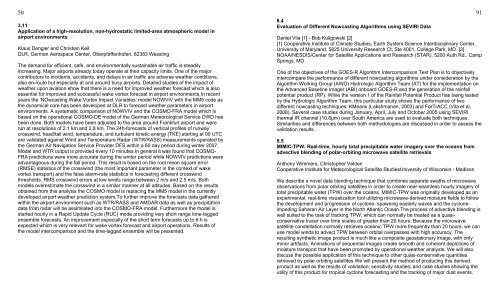World Meteorological Organization Symposium on Nowcasting - WMO
World Meteorological Organization Symposium on Nowcasting - WMO
World Meteorological Organization Symposium on Nowcasting - WMO
Create successful ePaper yourself
Turn your PDF publications into a flip-book with our unique Google optimized e-Paper software.
50<br />
8.4<br />
3.11 Evaluati<strong>on</strong> of Different <strong>Nowcasting</strong> Algorithms using SEVIRI Data<br />
Applicati<strong>on</strong> of a high-resoluti<strong>on</strong>, n<strong>on</strong>-hydrostatic limited-area atmospheric model in<br />
airport envir<strong>on</strong>ments<br />
Klaus Dengler and Christian Keil<br />
DLR, German Aerospace Center, Oberpfaffenhofen, 82383 Wessling<br />
The demand for efficient, safe, and envir<strong>on</strong>mentally sustainable air traffic is steadily<br />
increasing. Major airports already today operate at their capacity limits. One of the major<br />
c<strong>on</strong>tributors to incidents, accidents, and delays in air traffic are adverse weather c<strong>on</strong>diti<strong>on</strong>s,<br />
also en-route but especially at and around busy airports. Detailed studies of the impact of<br />
weather up<strong>on</strong> aviati<strong>on</strong> show that there is a need for improved weather forecast which is also<br />
essential for improved and successful wake vortex forecast in airport envir<strong>on</strong>ments.In recent<br />
years the ‘NOwcasting Wake Vortex Impact Variables’ model NOWVIV with the MM5 code as<br />
the dynamical core has been developed at DLR to forecast weather parameters in airport<br />
envir<strong>on</strong>ments. A systematic comparis<strong>on</strong> of NOWVIV and the COSMO-FRA model which is<br />
based <strong>on</strong> the operati<strong>on</strong>al COSMO-DE model of the German <str<strong>on</strong>g>Meteorological</str<strong>on</strong>g> Service DWD has<br />
been d<strong>on</strong>e. Both models have been adjusted to the area around Frankfurt airport and were<br />
run at resoluti<strong>on</strong>s of 2.1 km and 2.8 km. The 24h-forecasts of vertical profiles of runway<br />
crosswind, head/tail wind, temperature, and turbulent kinetic energy (TKE) starting at 00 UTC<br />
are validated against Wind and Temperature Radar (WTR/RASS) measurements operated by<br />
the German Air Navigati<strong>on</strong> Service Provider DFS within a 60 day period during winter 2007.<br />
Model and WTR output is provided every 10 minutes.In general it was found that COSMO-<br />
FRA predicti<strong>on</strong>s were more accurate during the winter period while NOWVIV predicti<strong>on</strong>s were<br />
advantageous during the fall period. This result is based <strong>on</strong> the root mean square error<br />
(RMSE) statistics of the crosswind (the most important parameter in the c<strong>on</strong>text of wake<br />
vortex transport) and the false alarm-rate statistics in forecasting different crosswind<br />
thresholds. RMS crosswind errors at low levels range between 2 m/s and 2.5 m/s. Both<br />
models overestimate the crosswind in a similar manner at all altitudes. Based <strong>on</strong> the results<br />
obtained from this analysis the COSMO model is replacing the MM5 model in the currently<br />
developed airport weather predicti<strong>on</strong> system.To further improve the forecasts data gathered<br />
within the airport envir<strong>on</strong>ment such as WTR/RASS and AMDAR data as well as precipitati<strong>on</strong><br />
data from radar will be assimilated into the COSMO-FRA model. Furthermore the model is<br />
started hourly in a Rapid Update Cycle (RUC) mode providing very short range time-lagged<br />
ensemble forecasts. An improvement especially of the short term forecasts up to 6 h is<br />
expected which is very relevant for wake vortex forecast and airport operati<strong>on</strong>s. Results of<br />
the model intercomparis<strong>on</strong> and the time-lagged ensemble will be presented.<br />
Daniel Vila [1] - Bob Kuligowski [2]<br />
[1] Cooperative Institute of Climate Studies, Earth System Science Interdisciplinary Center,<br />
University of Maryland, 5825 University Research Ct, Ste 4001, College Park, MD [2]<br />
NOAA/NESDIS/Center for Satellite Applicati<strong>on</strong>s and Research (STAR), 5200 Auth Rd., Camp<br />
Springs, MD<br />
One of the objectives of the GOES-R Algorithm Intercomparis<strong>on</strong> Test Plan is to objectively<br />
intercompare the performance of different nowcasting algorithms under c<strong>on</strong>siderati<strong>on</strong> by the<br />
Algorithm Working Group (AWG) Hydrologic Algorithm Team (AT) for the implementati<strong>on</strong> <strong>on</strong><br />
the Advanced Baseline Imager (ABI) <strong>on</strong>board GOES-R and the generati<strong>on</strong> of the rainfall<br />
potential product (RP). While the versi<strong>on</strong> 1 of the Rainfall Potential Product has being tested<br />
by the Hydrologic Algorithm Team, this particular study shows the performance of two<br />
different nowcasting techniques: KMeans (Lakshmanan, 2003) and ForTrACC (Vila et al,<br />
2008). Several case studies during January, April, July and October 2005 using SEVIRI<br />
thermal IR channel (10.8μm) over South America are used to evaluate both techniques.<br />
Similarities and differences between both methodologies are discussed in order to assess the<br />
validati<strong>on</strong> results.<br />
8.5<br />
MIMIC-TPW: Real-time, hourly total precipitable water imagery over the oceans from<br />
advective blending of polar-orbiting microwave satellite retrievals<br />
Anth<strong>on</strong>y Wimmers, Christopher Velden<br />
Cooperative Institute for <str<strong>on</strong>g>Meteorological</str<strong>on</strong>g> Satellite StudiesUniversity of Wisc<strong>on</strong>sin - Madis<strong>on</strong><br />
We describe a novel data blending technique that combines separate swaths of microwave<br />
observati<strong>on</strong>s from polar orbiting satellites in order to create near-seamless hourly imagery of<br />
total precipitable water (TPW) over the oceans. MIMIC-TPW was originally developed as an<br />
experimental, real-time visualizati<strong>on</strong> tool utilizing microwave-derived moisture fields to follow<br />
the development and progressi<strong>on</strong> of cycl<strong>on</strong>e- spawning easterly waves and the cycl<strong>on</strong>eimpeding<br />
Saharan Air Layer in the North Atlantic Ocean.The process of advective blending is<br />
well suited to the task of tracking TPW, which can normally be treated as a quasic<strong>on</strong>servative<br />
tracer over time scales of greater than 20 hours. Because the microwave<br />
satellite c<strong>on</strong>stellati<strong>on</strong> normally retrieves oceanic TPW more frequently than 20 hours, we can<br />
use model winds to advect TPW between orbital overpasses with high accuracy. The<br />
resulting synthetic image product is much like a composite geostati<strong>on</strong>ary image, with <strong>on</strong>ly<br />
minor artifacts. Animati<strong>on</strong>s of sequential images create smooth and coherent depicti<strong>on</strong>s of<br />
moisture transport that have been promoted by operati<strong>on</strong>al weather analysts. We will also<br />
discuss the possible applicati<strong>on</strong> of this technique to other quasi-c<strong>on</strong>servative quantities<br />
retrieved by polar orbiting satellites.We will present the method of producing this derived<br />
product as well as the results of validati<strong>on</strong>; sensitivity studies; and case studies showing the<br />
utility of this product for tropical cycl<strong>on</strong>e forecasting and the tracking of major dust events.<br />
91

















